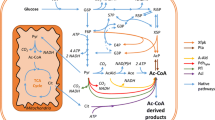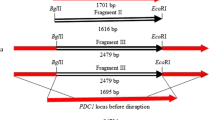Abstract
Saccharomyces cerevisiae is sensitive to d-amino acids: those corresponding to almost all proteinous l-amino acids inhibit the growth of yeast even at low concentrations (e.g. 0.1 mM). We have determined that d-amino acid-N-acetyltransferase (DNT) of the yeast is involved in the detoxification of d-amino acids on the basis of the following findings. When the DNT gene was disrupted, the resulting mutant was far less tolerant to d-amino acids than the wild type. However, when the gene was overexpressed with a vector plasmid p426Gal1 in the wild type or the mutant S. cerevisiae as a host, the recombinant yeast, which was found to show more than 100 times higher DNT activity than the wild type, was much more tolerant to d-amino acids than the wild type. We further confirmed that, upon cultivation with d-phenylalanine, N-acetyl-d-phenylalanine was accumulated in the culture but not in the wild type and hpa3Δ cells overproducing DNT cells. Thus, d-amino acids are toxic to S. cerevisiae but are detoxified with DNT by N-acetylation preceding removal from yeast cells.




Similar content being viewed by others
References
Briza P, Ellinger A, Winkler G, Breitenbach M (1990) Characterization of a dl-dityrosine-containing macromolecule from yeast ascospore walls. J Biol Chem 265:15118–15123
Calender R, Berg P (1966a) Purification and physical characterization of tyrosyl ribonucleic acid synthetases from Escherichia coli and Bacillus subtilis. Biochemistry 5:1681–1690
Calender R, Berg P (1966b) The catalytic properties of tyrosyl ribonucleic acid synthetases from Escherichia coli and Bacillus subtilis. Biochemistry 5:1690–1695
D’Aniello A, Di Fiore MM, Fisher GH, Milone A, Seleni A, D’Aniello S, Perna AF, Ingrosso D (2000) Occurrence of d-aspartic acid and N-methyl-d-aspartic acid in rat neuroendocrine tissues and their role in the modulation of luteinizing hormone and growth hormone release. Faseb J 14:699–714
D’Aniello A, D’Onofrio G, Pischetola M, D’Aniello G, Vetere A, Petrucelli L, Fisher GH (1993) Biological role of d-amino acid oxidase and d-aspartate oxidase Effects of d-amino acids. J Biol Chem 268:26941–26949
Dedkova LM, Fahmi NE, Golovine SY, Hecht SM (2003) Enhanced d-amino acid incorporation into protein by modified ribosomes. J Am Chem Soc 125:6616–6617
Ercal N, Luo X, Matthews RH, Armstrong DW (1996) In vitro study of the metabolic effects of d-amino acids. Chirality 8:24–29
Eswaramoorthy S, Gerchman S, Graziano V, Kycia H, Studier FW, Swaminathan S (2003) Structure of a yeast hypothetical protein selected by a structural genomics approach. Acta Crystallogr D Biol Crystallogr 59(Pt 1):127–135
Grenson M, Hou C, Crabeel M (1970) Multiplicity of the amino acid permeases in Saccharomyces cerevisiae IV Evidence for a general amino acid permease. J Bacteriol 103:770–777
Ishio S, Yamada H, Hayashi M, Yatsushiro S, Noumi T, Yamaguchi A, Moriyama Y (1998) d-Aspartate modulates melatonin synthesis in rat pinealocytes. Neurosci Lett 249:143–146
Kumagai H, Kashima N, Yamada H (1970) Racemization of d- or l-alanine by crystalline tyrosine phenol–lyase from Escherichia intermedia. Biochem Biophys Res Commun 39:796–801
LaRue TA, Spencer JF (1967) The utilization of d-amino acids by yeasts. Can J Microbiol 13:777–788
Miles EW, Phillips RS, Yeh HJ, Cohen LA (1986) Isomerization of (3S)-2,3-dihydro-5-fluoro-l-tryptophan and of 5-fluoro-l-tryptophan catalyzed by tryptophan synthase: studies using fluorine-19 nuclear magnetic resonance and difference spectroscopy. Biochemistry 25:4240–4249
Nagata Y, Fujiwara T, Kawaguchi-Nagata K, Fukumori Y, Yamanaka T (1998) Occurrence of peptidyl d-amino acids in soluble fractions of several eubacteria, archaea and eukaryotes. Biochim Biophys Acta 1379:76–82
Rytka J (1975) Positive selection of general amino acid permease mutants in Saccharomyces cerevisiae. J Bacteriol 121:562–570
Sherman F (1991) Getting started with yeast. Methods Enzymol 194:3–21
Snyder SH, Ferris CD (2000) Novel neurotransmitters and their neuropsychiatric relevance. Am J Psychiatr 157:1738–1751
Soutourina J, Blanquet S, Plateau P (2000) d-Tyrosyl-tRNA(Tyr) metabolism in Saccharomyces cerevisiae. J Biol Chem 275:11626–11630
Soutourina J, Plateau P, Blanquet S (2000) Metabolism of d-aminoacyl-tRNAs in Escherichia coli and Saccharomyces cerevisiae cells. J Biol Chem 275:32535–32542
Soutourina J, Plateau P, Delort F, Peirotes A, Blanquet S (1999) Functional characterization of the d-Tyr-tRNATyr deacylase from Escherichia coli. J Biol Chem 274:19109–19114
Soutourina O, Soutourina J, Blanquet S, Plateau P (2004) Formation of d-tyrosyl-tRNATyr accounts for the toxicity of d-tyrosine towards Escherichia coli. J Biol Chem 279:42560–42565
Uo T, Yoshimura T, Tanaka N, Takegawa K, Esaki N (2001) Functional characterization of alanine racemase from Schizosaccharomyces pombe: a eucaryotic counterpart to bacterial alanine racemase. J Bacteriol 183:2226–2233
Wada M, Nakamori S, Takagi H (2003) Serine racemase homologue of Saccharomyces cerevisiae has l-threo-3-hydroxyaspartate dehydratase activity. FEMS Microbiol Lett 225:189–193
Wang H, Wolosker H, Morris JF, Pevsner J, Snyder SH, Selkoe DJ (2002) Naturally occurring free d-aspartate is a nuclear component of cells in the mammalian hypothalamo-neurohypophyseal system. Neuroscience 109:1–4
Watanabe A, Yoshimura T, Mikami B, Hayashi H, Kagamiyama H, Esaki N (2002) Reaction mechanism of alanine racemase from Bacillus stearothermophilus: x-ray crystallographic studies of the enzyme bound with N-(5′-phosphopyridoxyl)alanine. J Biol Chem 277:19166–19172
Wolosker H, Blackshaw S, Snyder SH (1999) Serine racemase: a glial enzyme synthesizing d-serine to regulate glutamate-N-methyl-d-aspartate neurotransmission. Proc Natl Acad Sci USA 96:13409–13414
Wolosker H, D’Aniello A, Snyder SH (2000) d-Aspartate disposition in neuronal and endocrine tissues: ontogeny, biosynthesis and release. Neuroscience 100:183–189
Yow GY, Uo T, Yoshimura T, Esaki N (2004) d-Amino acid-N-acetyltransferase of Saccharomyces cerevisiae: A close homolog of histone acetyltransferase Hpa2p acting exclusively on free d-amino acids. Arch Microbiol 182:396–403
Zenk MH, Schmitt JH (1965) Purification and properties of acetyl-CoA: d-amino acid-α-N- acetyltransferase from yeast. Biochem Z 342:54–65
Acknowledgements
This work was supported in part by the Grant-in-Aid for Scientific Research 16380069 (to T.Y.) and 09460049 (to N.E.), and Grant-in-Aid for Scientific Research on Priority Areas (B) 13125203 (to N.E.) from the Ministry of Education, Culture, Sports, Science, and Technology, and by the Pioneering Research Project (to T.Y.) in Biotechnology of the Ministry of Agriculture, Forestry, and Fisheries.
Author information
Authors and Affiliations
Corresponding author
Rights and permissions
About this article
Cite this article
Yow, GY., Uo, T., Yoshimura, T. et al. Physiological role of d-amino acid-N-acetyltransferase of Saccharomyces cerevisiae: detoxification of d-amino acids. Arch Microbiol 185, 39–46 (2006). https://doi.org/10.1007/s00203-005-0060-x
Received:
Revised:
Accepted:
Published:
Issue Date:
DOI: https://doi.org/10.1007/s00203-005-0060-x




